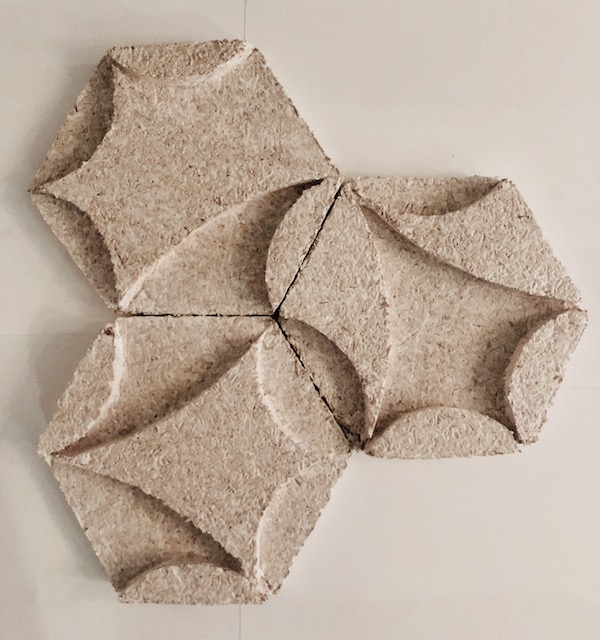
Soft Materials Class Grows Mushrooms to Improve Acoustics
Last semester, a group of Parsons students enrolled in a School of Constructed Environments class called “Soft Fab,” spent weeks growing Mycelium, the network of vegetative fiber for fungi that produce mushrooms. Since the growth of Mycelium is dependent on having just the right amount of moisture and keeping out the cold, several students chose to grow the fungi in their bathrooms, on their living room heaters. or under their classroom studio tables.
The purpose of the exercise was to create a soft healthy material that could be utilized to mitigate the ambient noise in the SCE conference room. In 2017, Mycelium tiles had been successfully used with other materials like cork by the Healthy Materials Lab in their Hush Room project to help create quieter rooms for SCE.
“Soft FAB was developed to encourage students to deepen their understanding of soft materials and how softness is explored in interiors,” said Yu Nong Khew, assistant professor of interior design. “Students learned to explore the notion of softness in interiors with particular focus on how soft materials hug and touch the human body, as well as acoustics, light transmittance and temperature.”
During the semester, Khew encouraged her students to explore using compostable materials such as wool and mycelium and reflect on how these materials when used in original ways can “produce an experiential affect in spaces.”
“The goal of the course was to introduce students to compostable soft materials used in interiors, as well as develop digital and physical skills associated with the making of soft interiors,” Khew said.
The idea to develop the class came from what Khew says was a need to for a curriculum where soft materials could be the focus.
Student Benjamin Kapoor designed his acoustic mycelium wall panel “based on a visualization of sound waves.”
“If we look at a room in terms of maximum and minimum decibel levels, the max occurs at eye level for the average human being,” he wrote. “Thus, this was a pattern generated to reflect the varying decibel levels of an interior environment, with lower decibel count at the floor and ceiling level and higher decibel count in the middle of the room”
Helping the class to learn the intricacies of growing mycelium was Andrew Olesh, the outreach coordinator for the NYC Compost Project at the Queens Botanical gardens.
Olesh gave the class a “mycelium 101 lecture” on how to extract spores and the keys to growing and keeping mycelium alive. It can take from one week to one month to grow the fungi and the longer the mycelium grows the stronger the panels become.
“He joined us as guest critic for the finals and was very encouraged by how the students managed to use his lessons on mycelium to design and fabricate wall and ceiling panels out of mycelium, Khew said about Olesh.
Another guest lecturer who brought decades of experience to the class was John Storyk, an acoustician and founder of WSDG, an architectural acoustical consulting firm. Storyk gave a lecture on the science of acoustics and how acoustics affects space and how form can affect the absorption and diffusion of sound. Famously, Storyk is known for his work designing Jimmi Hendrix’s Electric Lady Studios and NYC’s Jazz at Lincoln Center.
In addition to the mycelium project, which was the third and final project of the semester, students used paper and cardboard for their first project which was then recycled as a base/food for growing mycelium. Project two required students to work with 100 percent wool felt.